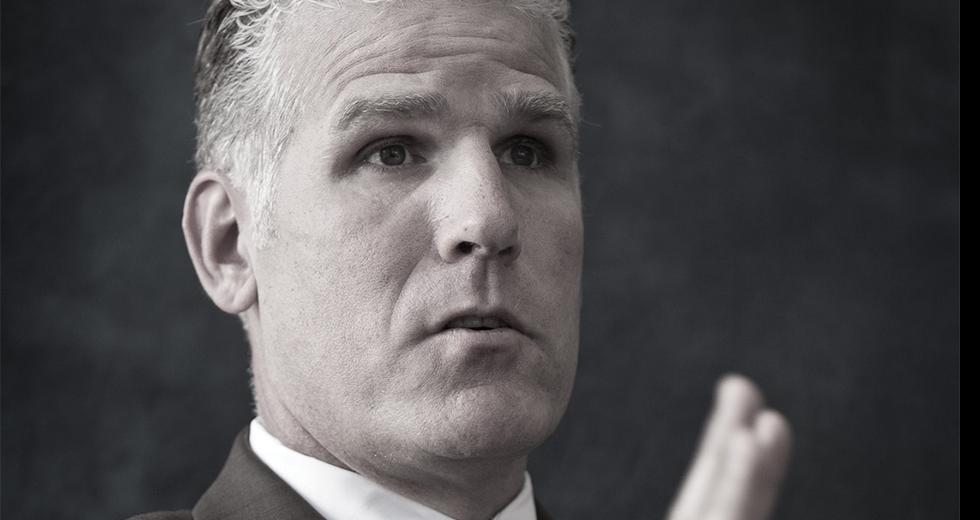No one can accuse Matt Cate of avoiding the hard jobs. During his four years at the helm of California’s state prisons, he guided the system through some of its toughest times, including historic budget cuts and the implementation of Gov. Jerry Brown’s controversial 2011 realignment plan, which shifted tens of thousands of offenders to local jails and parole supervision.
He left that position in 2012 to take on another formidable post with the California State Association of Counties, the advocacy voice for the state’s 58 very diverse counties. We sat down with him recently to talk about some of the difficulties those counties are facing.
Comstock’s: California’s economy now appears to be in its best shape in years. What’s your take on how we are doing?
Cate: We still have a number of counties trying to work their way out of the recession. The recovery hasn’t hit every county at the same pace. So when you ask counties how the economy is doing, you get 58 different answers. From a county’s perspective, if the state gets a cold, counties are the ones sneezing. Or vice versa. We’re the implementers of state programs, so as we’ve seen property taxes and sales taxes start to bounce back, counties are seeing funds available to run their programs.
Comstock’s: Senate pro Tem Darrell Steinberg has been very open about the need to get a water bond on the ballot this year. Is it critical, from your perspective, that 2014 be the year?
Cate: I think the drought has made it more difficult to put off solutions that start to address the problem. The Association of Counties doesn’t have a position on whether it should be this year or two years from now; we’re open to continuing discussions about the timing. Between the pro Tem and the governor, there’s a lot of political experience when it comes to initiatives. They have a lot more experience than I have, certainly. But I do know there is a groundswell of support for solutions, so at least it should be really well defined this year. That’s what we’re trying to see.
Comstock’s: We’re now a few years into Gov. Brown’s very controversial prison realignment plan. As the former head of our state prison system, you are intimately familiar with realignment and its impact on counties, which have borne the biggest burden for making it work. Assess for me your view on how the process is playing out.
Cate: When I talk to people about how realignment is going, I like to remind folks that it’s not fair to compare realignment with what was. You have to also compare it to what would have been without it.
The prisons were at one point crowded to almost 200 percent of their design capacity, with recidivism rates at 65 to 70 percent. We were spending $10 billion a year on prisons, and we had a court order that required a reduction in the prison population. We would certainly have been facing massive prisoner release orders from the federal courts, along with massive increases in the percentage of the state budget that prisons were going to take up. So I think realignment has overall worked even better than expected.
Violent crime rates have not changed, and that’s amazing. We’ve seen property crime rates go up but largely at the same rate as the rest of the country. A spike in auto thefts may be attributable to realignment, we just don’t know yet. Counties, though, are handling the populations as well as you can expect, but we’ve seen some problems arise that need to be fixed. Long-term jail sentences — Los Angeles has three guys serving 20 years or more in a jail setting — that has to be fixed. But I think the general consensus among most county law enforcement leaders is that they didn’t choose it, but now that it’s here, they’re making it work.
Comstock’s: Conversely there has been some criticism that counties have maybe not spent the money that the state allocates to them in the way that would probably produce the best results. By that I mean rehabilitative services, mental health services. What do you say to that kind of criticism?
Cate: I think it’s only appropriate to a point. You have to remember the context. When realignment took place, we had just finished the worst recession since the Great Depression, so county budgets had been devastated. Law enforcement everywhere had taken huge cuts. So people should have expected that the first bunch of funding would be spent on basics. That means jails and jail deputies. That means probation departments and their deputies. It means [district attorneys] and public defenders. Social services.
I think we’ll see it shift starting this year. You’ll see less money going toward law enforcement and more and more going to rehabilitative programs. You’ll see more and more going to this sweet spot, where you’re seeing the Affordable Care Act and the availability of behavioral health and treatment dollars being opened up and law enforcement now coming together. I think counties are identifying that blend of law enforcement and health care, whether that’s behavioral health or mental health, as an opportunity to really impact society.
Comstock’s: It has also been three years since Gov. Brown and the Legislature killed redevelopment agencies, one of local government’s strongest tools for combating blight and promoting economic development. There have been efforts to resurrect those agencies in one form or another. What is your perspective on all this? Will we eventually see redevelopment agencies return?
Cate: Well, the county supervisors have all different kinds of opinions on redevelopment. There were a number of them who thought it was helpful in terms of an economic engine, and there were many who were concerned about the fact that these redevelopment agencies could take counties’ property tax revenues and redistribute them without a vote of the people or a vote of the board. So that was problematic.
As a result of the unwinding of redevelopment agencies, we’ve seen $918 million returned to county coffers, which is obviously hugely helpful for counties that are trying to recover from the Sacramento malaise. That being said, it’s also true that we’re not opposed to a new approach. We think it would be helpful for counties to have more control over how and when these agencies are formed. And we also would like to make sure that if county tax revenues are going to be used that they go for projects that help county residents the most. So as long as there’s more individual county control, most counties are open to the idea of the redevelopment in a different, more robust form.
Comstock’s: Much of the heavy lifting of implementing the Affordable Care Act is being done at the county level. Where are counties with this? What are their biggest challenges?
Cate: Under state law, counties are the providers of last resort. If you’re a poor Californian and you’re ill, counties have a state mandated obligation to provide you with health care. When the Affordable Care Act came into place, counties were really working hard to make sure they could meet their obligations. What we’ve seen so far is 1.2 million Californians shifting from some kind of low-income, county health program to Medi-Cal, 100 percent funded by the Affordable Care Act. The reason that’s happened, largely, is that counties did great work to get ready. We have workers in every community and even in jails making sure the poor are getting signed up. We’ve also seen about 625,000 Californians join the (health insurance) exchange. A lot of those folks, while not sick right now, may have ended up in our emergency rooms and on our county rolls. So the ACA has been a big benefit to California, especially for counties.
Comstock’s: So your assessment is pretty positive? You think they’re in pretty good shape?
Cate: We’re in good shape in terms of how much work was done. The question is going to be, do the dollars balance out? Keep in mind that when the state gave us the responsibility to care for the poor in terms of health care, they also provided a funding stream. But when the ACA came out, the state cut that funding stream in most counties by 60 percent.
Comstock’s: With the idea that those people would not be your responsibility?
Cate: Exactly. So sometime this year, the math is going to get done and we’ll know how many have signed up for Medi-Cal, how many are in an exchange and how many we have left to cover. Because remember, at 40 percent (of funding) we still have to do public health, immunizations. All of those kinds of things are county responsibilities. Will there be enough money left to do all the jobs the counties are still responsible for?
Comstock’s: But you won’t know that for a while?
Cate: We won’t. We’re measuring now. We’re measuring uptake in terms of insurance and people becoming part of Covered California or part of Medi-Cal, and we’re also measuring how much we’re spending on those folks. So we’ll know closer to fall on how that’s working. And as part of the budget process, of course, we’ll come back and report to the legislature and the governor. If there’s augmentation that’s necessary, the CSAC’s job is to go fight for those dollars.
Recommended For You

GOP on Deck
Can the Republican contenders overcome Brown in 2014?
With just over a year until the midterm elections, California’s next gubernatorial race is starting to take shape.

The Plight of CADA
Where goes the neighborhood?
Three years ago, Gov. Jerry Brown pulled the plug on local government redevelopment agencies and the estimated $5 billion a year they spend rebuilding inner cities to combat urban blight.



